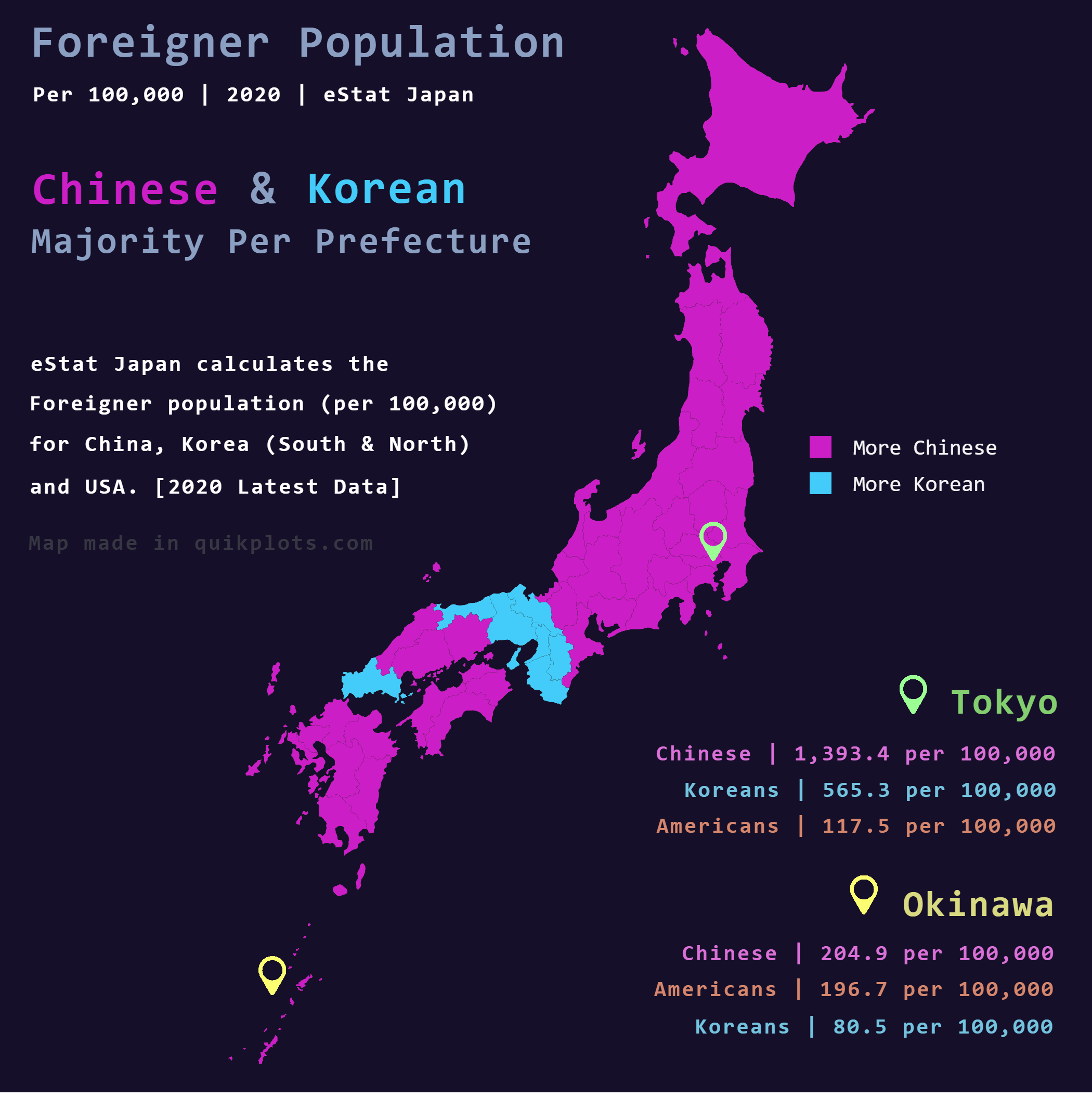Chinese and Korean Foreigners in Japan Map


Alex Cartwright
Senior Cartographer & GIS Specialist
Alex Cartwright is a renowned cartographer and geographic information systems specialist with over 15 years of experience in spatial analysis and data...
Geographic Analysis
What This Map Shows
The map titled "Chinese & Korean foreigners in Japan" provides a detailed visualization of the foreign population from China and Korea residing in Japan, calculated per 100,000 people. This data allows us to assess the demographic distribution and concentration of these communities across various prefectures in Japan. Understanding these patterns is crucial for grasping the cultural and social dynamics at play in one of the world's most vibrant nations.
Deep Dive into the Chinese and Korean Foreign Populations in Japan
Japan has a rich tapestry of foreign communities, with the Chinese and Korean populations being two of the most significant contributors. As of recent statistics, the Chinese community in Japan has grown substantially, making them the largest foreign group in the country. Interestingly, Chinese nationals account for a significant part of Japan's foreign labor force and student population. In urban areas such as Tokyo and Osaka, the concentration is particularly high, reflecting Japan's economic opportunities and educational institutions that attract Chinese migrants.
On the flip side, the Korean population in Japan is composed of both South Koreans and North Koreans, creating a unique blend of cultures and experiences. Historically, many Koreans came to Japan during the colonial period, and their descendants, known as Zainichi Koreans, often face distinct socio-political circumstances compared to more recent arrivals from South Korea. The current South Korean expatriates are drawn to Japan for various reasons, including employment, education, and cultural exchange.
The map visually illustrates these demographic dynamics, revealing areas of high concentration, particularly in metropolitan regions. For instance, Tokyo, with its vast economic and educational opportunities, boasts one of the highest ratios of Chinese nationals per 100,000 residents. Conversely, areas like Okinawa showcase a notable presence of Americans, reflecting historical military ties, yet they still fall behind the Chinese population in sheer numbers.
Regional Analysis
When we examine the map closely, notable regional differences emerge. Prefectures like Kanagawa and Osaka are hotspots for the Chinese population, often attributed to their bustling urban centers and the availability of job opportunities. Kanagawa, for example, is home to Yokohama, a city with a thriving international community, while Osaka is known for its open culture and extensive trade networks.
Interestingly, the relationship between the Korean population and specific regions is more complex. In areas such as Hyogo and Osaka, you can find significant Zainichi Korean communities, influenced by historical migration patterns. These communities often maintain their cultural heritage while integrating into Japanese society. However, the challenges they face, such as discrimination and identity issues, create a stark contrast to the experiences of newer South Korean migrants, who may not encounter the same level of societal barriers.
In contrast, rural areas tend to have lower concentrations of both Chinese and Korean foreigners, mainly due to limited economic opportunities and fewer educational institutions. For instance, regions in Hokkaido or Tohoku have a significantly lower representation of these foreign populations, highlighting the urban-rural divide in Japan's demographic landscape.
Significance and Impact
Understanding the distribution of Chinese and Korean foreigners in Japan is essential for several reasons. Firstly, it sheds light on Japan's evolving demographic landscape, especially as the country faces an aging population and declining birth rates. The influx of foreign nationals, particularly from neighboring countries, can help alleviate some of the labor shortages experienced in various sectors.
Moreover, the cultural exchange brought about by these populations fosters greater international understanding and cooperation. As more Chinese and Koreans settle in Japan, they contribute to cultural diversity, enriching local communities with their unique traditions and perspectives.
Lastly, monitoring these demographic trends is crucial for policymakers. As Japan continues to navigate its immigration policies, understanding the needs and contributions of these foreign populations will be vital to creating an inclusive society. With the ongoing globalization and interconnectedness of economies, the presence of Chinese and Korean nationals in Japan is likely to continue growing, making it a vital area of study for geographers and social scientists alike.
In conclusion, the map of Chinese and Korean foreigners in Japan not only highlights the current demographic trends but also serves as a lens through which we can explore the broader implications of migration and cultural exchange in Japanese society today.
Visualization Details
- Published
- October 11, 2025
- Views
- 6
Comments
Loading comments...